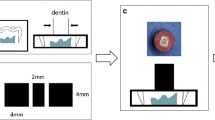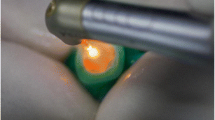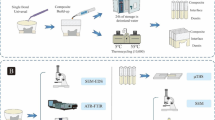Abstract
Introduction
The aim of this study was to evaluate the effect of different durations of Er,Cr:YSGG laser irradiation on dentin morphology using scanning electron microscopy (SEM).
Materials and methods
Twenty-five extracted human-impacted permanent third molars were cut below the occlusal pit and fissure level, perpendicular to the long axis of the tooth. An occlusal area measuring 5 mm in length and 5 mm in width was prepared on each tooth for laser irradiation. The teeth were randomly divided into five groups for different durations of laser irradiation: T1, 5 s; T2, 10 s; T3, 20 s; T4, 40 s; T0, no laser irradiation. The effects of laser application on dentin surfaces were evaluated using SEM at × 80 and × 500 magnifications. Also, the presence/absence of smear layer was scored according to SEM findings. Score 0 indicated the absence and score 1 indicated the presence of smear layer.
Results
Forty seconds of irradiation resulted in an irregular dentin surface without smear layer, with open dentinal tubules and without enlargement.
Conclusion
Laser preparation of dentin creates a retentive surface for composite restoration, without the problems caused by smear layer after conventional preparation. Also, the disadvantages of acid etching can be avoided as such.






Similar content being viewed by others
References
Shahabi S, Chiniforoush N, Bahramian H, Monzavi A, Baghalian A, Kharazifard M (2012) Comparison of tensile bond strength of composite to dentin in conventional or laser-prepared cavities (Er;Cr:YSGG). J Oral Laser Appl 10:107–110
Hibst R (2002) Laser for caries removal and cavity preparation: state of the art and future directions. J Oral Laser Appl 2(4):202–212
Valian A, Salehi E (2013) Fundamentals of operative dentistry Summitt’s. In: Hilton T. pp 434–435
Pashley DH, Tay FR, Breschi L, Tjäderhane L, Carvalho RM, Carrilho M, Tezvergil-Mutluay A (2011) State of the art etch-and-rinse adhesives. Dent Mater 27:1–16
Gwinnett AJ, Matsui A (1967) A study of enamel adhesives. The physical relationship between enamel and adhesive. Arch Oral Biol 12:1615–1620
Fusayama T (1980) New concepts in operative dentistry. Quintessence, Chicago
Eghbali F (2012) Craig’s restorative dental materials. In: Ronald A, John M. pp 332–333
Marshall SJ, Bayne SC, Baier R, Tomsia AP, Marshall GW (2010) A review of adhesion science. Dent Mater 26(2):e11–e16
Perdigao J (2007) New developments in dental adhesion. Dent Clin N Am 51(2):333–357
Liu Y, Tjäderhane L, Breschi L, Mazzoni A, Li N, Mao J, Pashley DH, Tay FR (2011) Limitations in bonding to dentin and experimental strategies to prevent bond degradation. J Dent Res 90:953–968
Breschi L, Mazzoni A, Ruggeri A, Cadenaro M, Di Lenarda R, De Stefano Dorigo E (2008) Dental adhesion review: aging and stability of the bonded interface. Dent Mater 24:90–101
Lopes GC, Vieira LC, Araújo E, Bruggmann T, Zucco J, Oliveira G (2011) Effect of dentin age and acid etching time on dentin bonding. J Adhes Dent 13:139–145
Ergücü Z, Çelik EU, Ünlü N, Türkün M, Özer F (2009) Effect of Er,Cr:YSGG laser on the microtensile bond strength of two different adhesives to the sound and caries-affected dentin. Oper Dent 34(4):460–466
Beer F, Buchmair A, Körpert W, Marvastian L, Wernisch J, Moritz A (2012) Morphology of resin–dentin interfaces after Er,Cr:YSGG laser and acid etching preparation and application of different bonding systems. Lasers Med Sci 27:835–841
Lee BS, Lin PY, Chen MH, Hsieh TT, Lin CP, Lai JY, Lan WH (2007) Tensile bond strength of Er, Cr:YSGG laser-irradiated human dentin and analysis of dentin–resin interface. Dent Mat 23:570–578
Eghbali F (2009) Low level or theraputic lasers. In: Fekrazad R (ed) Applying low level laser therapy in dentistry. Tehran: Shayan Nemoodar 44–45:19–20
Van As G (2004) Erbium lasers in dentistry. Dent Clin N Am 48:1017–1059
Ekworapoj P, Sidhu SK, McCabe JF (2007) Effect of different power parameters of Er, Cr:YSGG laser on human dentine. Laser Med Sci 22:175–182
Benderli Y, Gökçe M, Kazak M, Gürsoy T (2013) SEM comparison of acid etching, ER,CR:YSGG laser and combined treatment on dentin surfaces. Balk J Stom 17:79–86
Ramos ACB, Esteves-Oliveira M, Arana-Chavez VE, et al (2008) Adhesives bonded to erbium:yttrium-aluminum-garnet laser-irradiated dentin: transmission electron microscopy, scanning electron microscopy and tensile bond strength analysis. J Lasers Med Sci 25:181–189
Shahabi S, Chiniforoush N, Fekrazad R, Fatemi SM (2010) Comparison of tensile bond strength of composite to dentin in conventional or laser-prepared cavities (Er;Cr:YSGG). J Oral Laser Appl 10:107–110
Keller U, Hibst R (1989) Experimental studies of the application of Er:YAG laser on dental hard substances: II. Light microscopic and SEM investigations. Lasers Surg Med 9(4):345–351
Aoki A, Ishikawa I, Yamada T, Otsuki M, Watanabe H, Tagami J, Ando Y, Yamamoto H (1998) Comparison between Er:YAG laser and conventional technique for root caries treatment in vitro. J Dent Res 77:1404–1414
Schoop U, Kluger W, Moritz A, Nedjelik N, Georgopoulos A, Sperr W (2004) Bacterial effect of different laser systems in deep layers of dentin. Lasers Surg Med 35(2):111–116
Niu W, Eto J, Kimura Y, Takeda FH, Matsumoto K (1998) A study of microleakage after resin filling of class V cavities prepared by Er:YAG laser. J Clin Laser Med Surg 16(4):227–231
Tachibana A, Marques MM, Soler JMP, Matos AB (2008) Erbium, chromium:yttrium scandium gallium garnet laser for caries removal: influence on bonding of a self-etching adhesive system. Lasers Med Sci 23:435–441
Author information
Authors and Affiliations
Corresponding author
Ethics declarations
Conflict of interest
The authors declare that they have no conflict of interest.
Ethical approval
This article does not contain any studies with human participants or animals performed by any of the authors.
Informed consent
This article was done on extracted human third molars, and it does not include any human participant. For this type of study, formal consent is not required.
Electronic supplementary material
ESM 1
(DOCX 33 kb)
Rights and permissions
About this article
Cite this article
Mahdisiar, F., Mirzaei, A., Fallah, A. et al. Effect of duration of Er,Cr:YSGG laser etching on dentin morphology: an in vitro study. Laser Dent Sci 2, 213–219 (2018). https://doi.org/10.1007/s41547-018-0038-z
Received:
Accepted:
Published:
Issue Date:
DOI: https://doi.org/10.1007/s41547-018-0038-z




